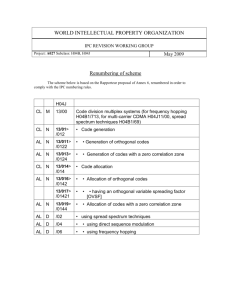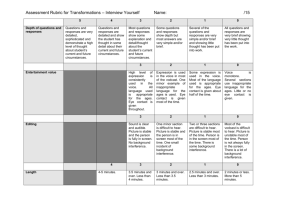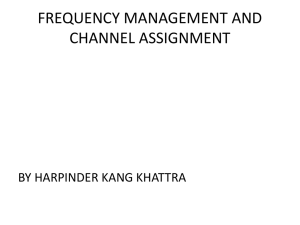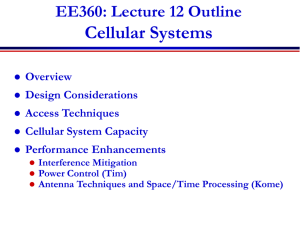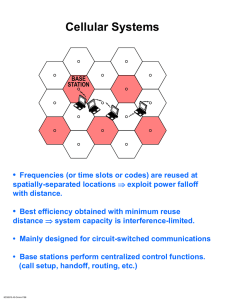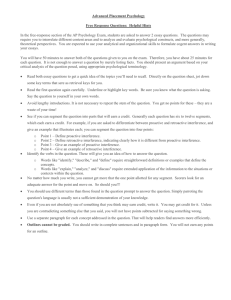Document
advertisement
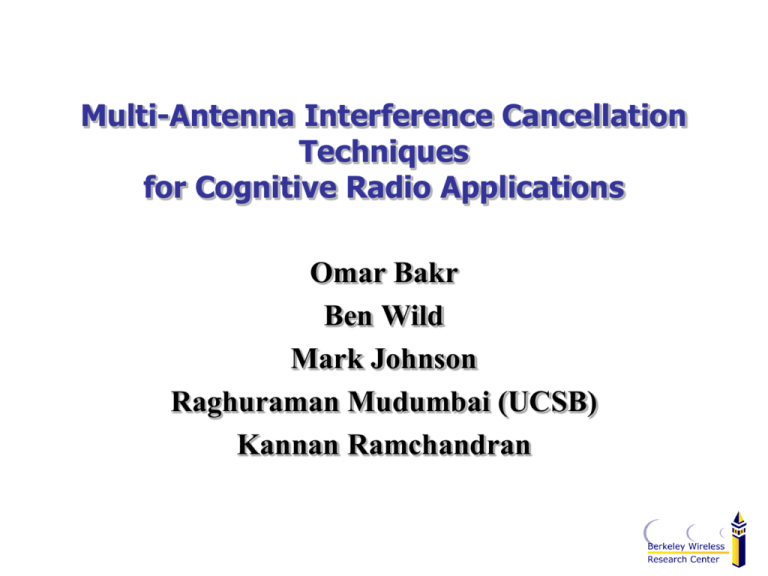
Multi-Antenna Interference Cancellation Techniques for Cognitive Radio Applications Omar Bakr Ben Wild Mark Johnson Raghuraman Mudumbai (UCSB) Kannan Ramchandran Last Time Improving spectrum reuse using primary and secondary collaboration1 More effective spatial reuse using multiple antennas on the secondary Example: cellular uplink reuse Today: signal processing and array processing techniques to improve collaboration To appear in IEEE WCNC 2009 1O. Bakr, M. Johnson, B. Wild, and K. Ramchandran, “A multi-antenna framework for spectrum reuse based on primary-secondary cooperation,” in IEEE Symposium on New Frontiers in Dynamic Spectrum Access Networks (DySPAN), October 2008. Cellular uplink reuse framework Collaborative framework for interference cancellation •hj for 0<j<K+1 are the channel responses from the secondary transmitter (SRt) to each of K primary users (base stations) respectively. •hd is the channel response from SRt to SRr. •Choose c to be the component of hd that is orthogonal to hj for 0<j<K+1 (projection) •Channels unknown apriori? Need to estimate. Estimation using adaptive filtering •Identifying an unknown filter (channel) H(z) using an adaptive filter (e.g. Least Mean Square (LMS) algorithm) •w[n] is a known pseudo random sequence, Gn(z) is the local estimate •Gn(z) will converge to a noisy estimate of H(z) (due to the presence of noise) •In the beamforming context, the taps of H(z) are the complex responses from each antenna element on the secondary radio towards a primary radio Beam-nulling using adaptive filtering Simulated interference rejection ~22dB attenuation Infinite phase/amplitude resolution Finite phase/amplitude resolution 4 primary users (base stations), cognitive radio has M antennas Iterative channel estimation Less coordination among primary users Better reuse of allocated channels Same adaptive algorithm, different choice of training sequence w Adaptively perform a Gram-Schmidt orthogonalization Start with the closest node (e.g. PR1) Run LMS at low power (no interference to other nodes) After estimating h1, increase the power and choose w orthogonal to h1 This will estimate the component of h2 orthogonal to h1 Increase the power, choose w orthogonal to both h1, h2 Simulated interference rejection ~22dB attenuation Infinite phase/amplitude resolution Finite phase/amplitude resolution 4 primary users (base stations), cognitive radio has 12 antennas What about the receiver Interference suppression framework Primary transmitters (cell phones) can cause interference to the secondary (cognitive radio) network At the secondary receiver: Choose beamforming (spatial filter) to maximize SINR SINRout=|chhd|2/(∑i |chhd|2 + Nν) MMSE criterion: y[n] = hdd[n] + ∑i hidi[n] + ν[n] cMMSE = arg minc |e[n]|2 = arg minc |chy[n] - d[n]|2 Good rejection in slow fading channels Doppler/frequency offsets can create problems Differential MMSE Framework2 Even in fast fading environments, channel remains relatively constant over successive symbols Avoid tracking channel variations by only looking at the difference (ratio) between symbols (similar to differential modulation) DMMSE criterion: 2U. cDMMSE = arg minc |chy[n-1]d[n] - chy[n]d[n-1] |2 Subject to E[|chy[n]|2]=1 Madhow, K. Bruvold, and L. J. Zhu, “Differential MMSE: A framework for robust adaptive interference suppression for ds-cdma over fading channels,” IEEE Transactions on Communications, vol. 53, no. 8, pp. 1377–1390, Aug. 2005. Simulated interference rejection DMMSE, offset=10% symbol rate NLMS, offset=1% symbol rate 8 antennas, 6 interferers, SNRin=-20dB, SIRin=-40dB


